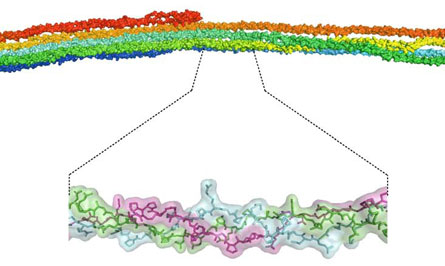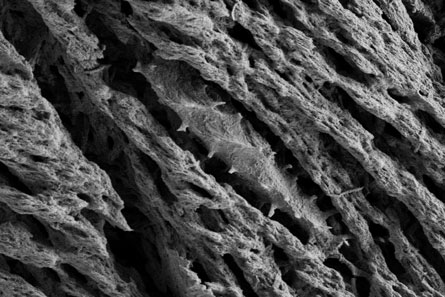- More than 2 years ago
Reports in recent years of soft dinosaur tissue from fossil bones of a T. rex and a duck-billed hadrosaur elicited skepticism from the scientific community. But a new analysis of the bits of protein that survived supports claims of ancient origins.


The same kinds of collagen building blocks extracted from the dinosaur fossils are found in sheltered, physically protected areas of collagen fibers in rats and humans, researchers report online June 8 in PLoS ONE.
Collagen is best known for its role in stretchy connective tissue such as tendons, ligaments and skin, but it’s also the primary protein in bone. At large scales, collagen fibers look pretty much the same: a triple helix of tightly twisted cords that together are further twisted and packed into larger ropes. But in any one section of the molecule the building blocks are different. The amino acids strung together to make the protein aren’t the same in all parts of a collagen fiber, and those differences dictate various interactions between the molecule and its neighborhood, says study coauthor Joseph Orgel of the Illinois Institute of Technology in Chicago.
“Most people regard collagen as a structural molecule, but it seems to function as an information molecule as well,” Orgel says. “There’s a whole constellation of chemical sites that tell cells how to interact with it.”
Those chemical characteristics, such as water-loving sections or regions with extra hydrogen bonding, also might make some parts of a collagen molecule more susceptible to degradation than others, Orgel and colleagues reasoned. So they investigated which particular amino acids were strung together in the collagen bits that had been previously extracted from 68-million-year-old Tyrannosaurus rex bones and an 80-million-year-old duck-billed dinosaur fossil. Then the researchers looked at where those particular bits show up in the collagen fibers of rats and humans. All of the snippets mapped to protected internal regions, where they might degrade more slowly than in other sections.
“None are in the exposed area of the fiber,” Orgel says. If any collagen could survive millions of years, it would not be a random assortment but the sheltered kinds of molecules that were observed, he says. “We were rather pleasantly surprised and taken aback.”
The work also hints at what chemical properties might impart stability and enhance preservation. Several of the 11 snippets had amino acids that are particularly water-hating, and there were few acidic molecules, the team found.
The results are exciting and the approach thoughtful, says Matthew Collins, an expert in ancient proteins and an early critic of the T. rex soft-tissue report.
“It’s a very good team that put this together,” he says. And the notion that collagen might degrade selectively could help authenticate claims of old proteins. Scientists like Collins are already using old proteins to peer back in time and figure out who is related to whom on the tree of life.
“But I’m an old protein cynic,” says Collins, of the University of York in England. The new research used data from the initial controversial reports. “Obviously we would like to see lots of samples from lots of labs,” he says. “I’m not convinced yet.”






